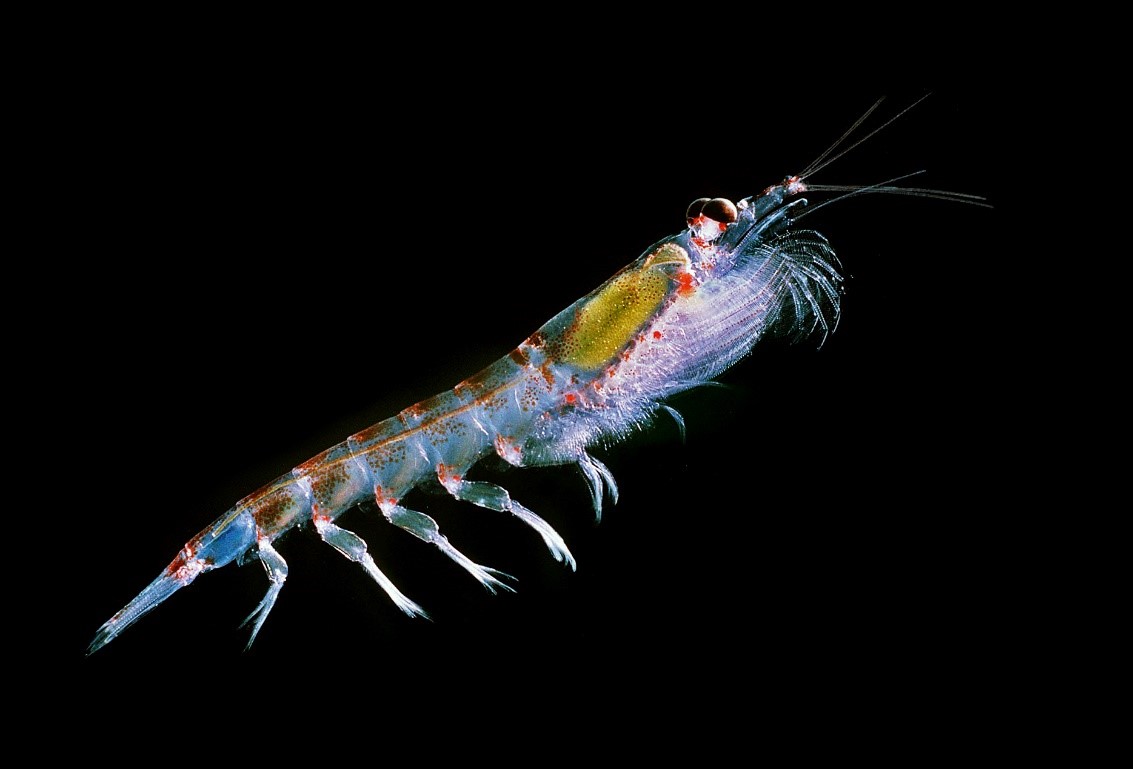Antarctic Krill under a microscope. Photo courtesy of Uwe Kils, CC-BY-SA 3.0
Paper: Manno et al. (2020)
The transfer of carbon from the surface ocean to the deep ocean, or carbon export, can strongly influence climate. The main pathway of carbon export in the ocean is through sinking particles, also known as the biological carbon pump. These sinking particles can include plankton biomass, aggregates of cells, and zooplankton feces and molts. Understanding what contributes to carbon export is important in understanding how this may change as temperatures warm due to climate change.
A recent study by Manno et al. found that Antarctic krill in the Southern Ocean may play a significant role in transporting carbon to the deep ocean through their carcasses, fecal material, and most notably their molts, or shedding of their shells. Exoskeletons are not only an important vehicle for carbon export but also provide food to animals living on the seafloor. This is the first study to investigate the contribution of krill molts to carbon export in the Southern Ocean.
Many animals shed their exoskeletons, so why are krill molts so important? For one, krill are abundant in the Southern Ocean and molt regularly throughout their lives, while most other crustaceans mainly molt as juveniles (because they are growing quickly and thus need to shed their external layer) and during seasonal or life-stage shifts. This continuous shedding means that krill produce more molts than other crustaceans; their molts are made of chitin, which is a biopolymer containing a lot of carbon. Once shed, molts sink and carry the material with them to the deep ocean.
One very common way to study carbon export is with sediment traps; these sampling devices collect sinking material for scientists to analyze. The sediment trap in this study was moored 300 meters deep in the Scotia Sea in the Southern Ocean for one year. In order to measure the amount of organic carbon over time—known as a time-series—there are multiple cups that collect the material sequentially so that the material in each cup can be indicative of a set time period (for example, two weeks). This allows scientists to be able to evaluate changes in carbon flux over different seasons.
The authors of this study found that krill-related material (including exoskeletons, feces, and carcasses) dominates carbon export in this region, making up almost 90% of the annual organic carbon flux! The role of fecal pellets in carbon export has recently become a hot-topic of study, but these new results show that krill molts export almost as much carbon in this region as their fecal material.
The data also show that carbon export varies significantly over different seasons, with most of the carbon export occurring in summer, which is December through March in the Southern Ocean. Krill carcasses dominate carbon export in the winter and spring when very little total carbon export occurs, possibly due to the seasonal vertical migrations of krill deeper than the sediment trap and decreased krill activity, meaning less feeding, growth and molting. Total carbon export is much higher in the summer and is dominated by fecal pellets and molts.
This study shows for the first time the significant contribution of krill molts to carbon export in the Southern Ocean. The authors discuss how changes in the amount of krill could significantly affect carbon export in this region. This may be of concern with respect to climate change, as changes in temperature and sea ice may impact krill populations as well as affect molting rates. Water temperature changes due to climate change have the potential to alter this very important carbon export pathway.
Antarctic krill and their role in carbon cycling by Lillian Henderson is licensed under a Creative Commons Attribution-ShareAlike 4.0 International License.

